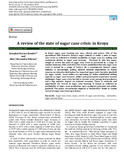| dc.contributor.author | Kombo, Josephat Barasa | |
| dc.contributor.author | Ndiema, Alice Chesambu | |
| dc.date.accessioned | 2023-01-18T11:41:57Z | |
| dc.date.available | 2023-01-18T11:41:57Z | |
| dc.date.issued | 2022-10-29 | |
| dc.identifier.issn | https://doi.org/10.15739/IJAPR.23.003 | |
| dc.identifier.uri | https://journalissues.org/ijapr/wp-content/uploads/sites/5/2022/12/Kombo-and-Ndiema-.pdf | |
| dc.identifier.uri | http://ir-library.mmust.ac.ke:8080/xmlui/handle/123456789/2156 | |
| dc.description.abstract | In Kenya sugar cane farming was once vibrant and source 15% of the
agricultural GDP. However, Kenya’s sugar industry is under a state of sugar
cane crisis as reflected in limited availability of sugar cane for milling and
continuous decline in sugar cane farming. Pursuant to this, this paper
sought to review the state of sugar cane crisis as perceived by a range of
scholars between 1981 and 2022.The review established that the sugar cane
crisis is caused by a range of factors. As a consequence, Kenya’s sugar
industry is increasingly getting skewed towards importation as Kenya
remains an attractive destination for imported sugar and a lucrative playfield
for sugar cartels. Local millers are operating far below established milling
capacity as sugar cane farmers, millers and government experience income
challenges. Sugar cane crisis has led to income crisis among local producers
and a big negative impact on national economy. There is rationale and
opportunity for revival of sugar cane farming in Kenya as reflected in
profitability of sugar cane production, agro ecological potential and public
goodwill. The paper recommends adoption of Kombo2022 Model to enable
revival of sugar cane farming in Kenya. | en_US |
| dc.language.iso | en | en_US |
| dc.publisher | International Journal of Agricultural Policy and Research | en_US |
| dc.subject | review,state,sugar, cane, crisis | en_US |
| dc.title | A review of the state of sugar cane crisis in Kenya | en_US |
| dc.type | Article | en_US |

